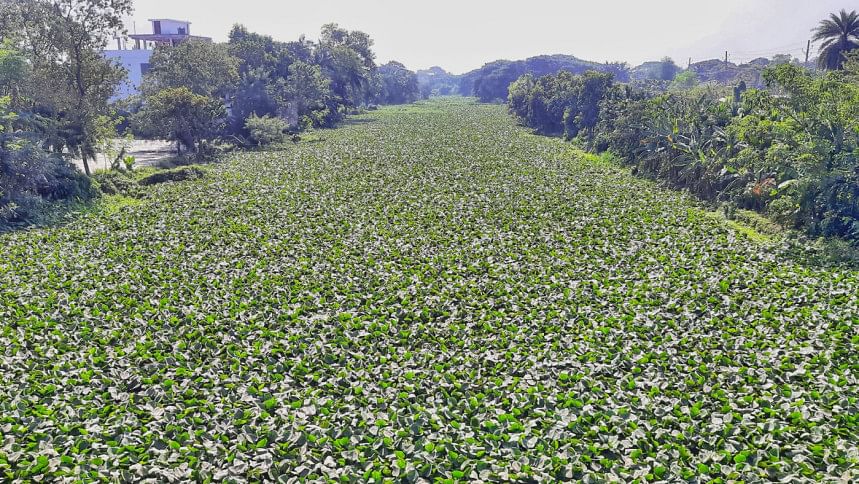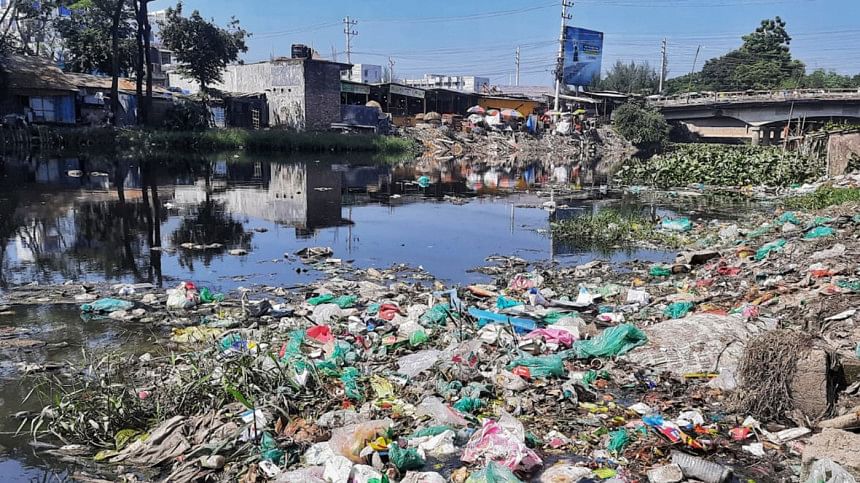Pollution puts Mayur in peril

In 2014-15, Tk 5.78 crore was spent for the river's excavation, and the outcome was almost zero. The city corporation did the work without any proper survey and technical analysis. They have decided to excavate the river again, spending Tk 7.59 crore. It will be an eyewash too.
Due to continuous encroachment and unchecked pollution, Mayur, one of the main freshwater rivers of Khulna, is at death's throes.
Rapid growth of water-hyacinths has turned the 12-km river, flowing beside the southwestern side of the city, into a bane for locals, as they have been unable to use the water for any purpose for years, said locals.
As if that was not enough, most of Khulna city's waste is released into the river through approximately 26 drains. As a result, around two lakh people living in adjacent areas under Khulna City Corporation (KCC) and surrounding villages are being deprived of water resources.
Mayur flows through Alutola, Nirala, Gallamary, Boyra, Dayana, Arongghata, and Bildakatia areas.
Visiting different points of the river recently, including those at Alutola gate, Sachibunia, Gallamari, Sonadaga bypass bridge, Boyra cremation area, Rayer Mahal and Dayana, it was seen that 15 small and big drains are directly connected to the river. Apart from this, waste from slaughterhouses in Gallamari area, markets and various farms along the river fall directly into the waterbody.
In 1986, a sluice gate was built in Alutala of Batiaghata, to save the agricultural lands from saline water and tidal surges. Presently, the sluice gate cannot even drain out water.
Sazzad Hossain, a resident of Rayer Mahal area, said Mayur, once a storehouse of freshwater fish and a helping hand for agriculture, has now become a severely polluted, water-hyacinth riddled waterbody.

Nirod Roy (60), a fisher of Line Bilbapla of Dumuria, said many villagers of Batiaghata and Dumuria, along with city dwellers used to earn a living by fishing, while farmers were blessed with good yields, he said.
Now, the river has become a breeding ground for mosquitoes, as its water remains stagnant due to the hyacinths, he added.
According to KCC, a technical committee was formed in February 2019 to compile a list of illegal grabbers. They listed 362 establishments, constructed by 470 individuals and organisations occupying the river and 26 adjoining canals.
The grabbers are still active, alleged locals.
"In 2014-15, Tk 5.78 crore was spent for the river's excavation, and the outcome was almost zero. The city corporation did the work without any proper survey and technical analysis. They have decided to excavate the river again, spending Tk 7.59 crore. It will be an eyewash too," said Kudrat-e Khuda, a civil-society member of Khulna.
According to Department of Environment (DoE), the level of dissolved oxygen in the water of Mayur is currently 0.2-0.6 mg per litre, whereas the ideal amount should be more than 5 mg per litre.
Due to the low levels of dissolved oxygen, the river water is harmful to aquatic animals and to public health, according to the environment protection agency.
Nuruzzaman Talukder, member secretary of the river eviction committee and KCC's state officer, said, "Every week, our people visit the Mayur area. Anyone who tried to occupy was evicted and brought to the police station. No one has occupied the river anew."
After excavation work, the river will get back its water flow, he added.
In September 2016, the Khulna office of DoE sent a letter to the DG of the department, pointing out that unplanned waste management is responsible for the declining oxygen levels in the river and recommended improving Mayur's water quality.
Khulna University conducted two studies on the river's water, in 2013 and 2020, led by Dilip Kumar Datta, professor of environmental science.
"Our research in 2020 was mainly on the water security of Khulna city. We found that to meet the water demand of the city, Mayur can be developed as a reservoir of fresh water," Dilip said.

 For all latest news, follow The Daily Star's Google News channel.
For all latest news, follow The Daily Star's Google News channel. 



Comments